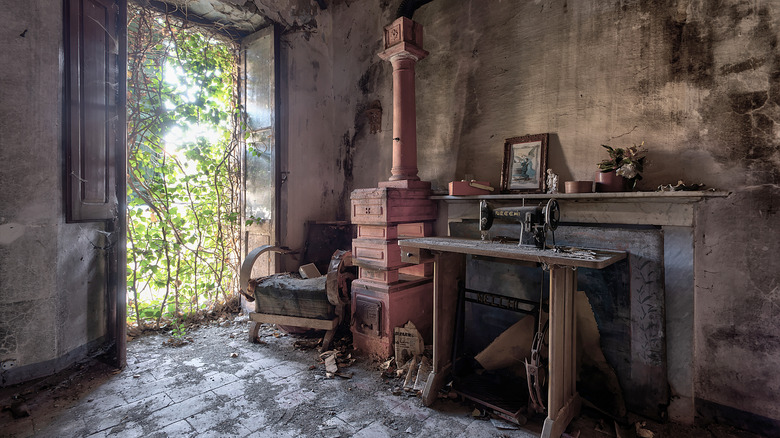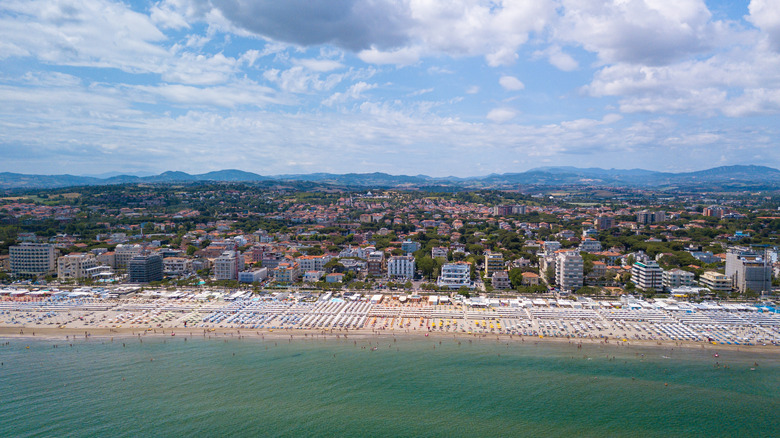Italy's Museum Of Abandonment Sits As A Reminder Of Its Failed Fascist Past
When you think of an abandoned area, you might think about crumbling buildings, overgrown lots, or places that nature has reclaimed entirely. But one spot in Italy wants to change people's minds about abandoned areas and their potential to bloom into something beautiful.
As Spazi Indecisi explains, if you know a deserted area in Italy, you can reach out to this museum and tell them about it. If they think it's a good spot to add to their Museum of Abandonment, it may just be the newest location in their growing experimental project. So, where and what is the Museum of Abandonment?
Since 2010, Spazi Indecisi has been putting on an experimental museum exhibition across parts of Italy. Their app, "In Loco," is available online, but the museum also offers a map where you can explore by yourself, or follow a guided tour. This is not your average museum — and they have an important reason to remind people of the past.
Italy's fascist period began around the time Mussolini took power in 1919, and lasted until 1943, per Britannica, so many of the abandoned spaces along the route are from this time period. During this time, Mussolini and the government were responsible for many civilian deaths, and they worked to undermine the democracy of Italy by getting rid of elections, banning unions, and outlawing free speech. By the 1930s, fascism was in full swing and controlled basically every aspect of an Italian citizen's daily life.
Reminders of facist Italy
Many buildings had slogans in support of Benito Mussolini written on them, and all jobs, holidays, and recreational activities were controlled by the government (per Britannica). In 1938, the Italian government instituted antisemitic laws, banning Jewish people from nearly all aspects of life. In order to prevent Italy's past from being forgotten, the museum uses educational activities to learn about history in a tangible way, according to In Loco. Far from the quiet halls of a typical museum, this exhibit will get visitors on their feet to visit historic venues on a preplanned outdoor route.
According to Designboom, venues are always being added to the exhibition. There are numerous sites to see, but all have a historical purpose. For example, you can see the old ATR bus depot in Forlì. What's so special about an abandoned bus station? Well, this station was formerly home to some of the 20th century's biggest Italian workplaces, which the viewers can learn about by visiting and experiencing the sights, smells, sounds, and textures of the environment firsthand.
Acquedotto spinadello is another locale that visitors can roam; it contains factories, school buildings, and an aqueduct dating back to the former Italian regime. According to ATRIUM, the exhibit reminds people how spaces can be utilized once they're abandoned. This aqueduct ran from the 1930s to the 1980s — then plant life took over for years.
The seven itinerary routes
In order to repurpose the space, Spazi Indecisi took over acquedotto spinadello and added it to the Museum of Abandonment tour (via ATRIUM). Now, the space is beloved once again. The public can now go birdwatching, camping, take walks, stop by the visitor's center, or enjoy the abundant plant life.
According to Designboom, Spazi Indecisi always does additional research on these places to create a vivid picture of the past. According to "The Potential of Neglected Places In Loco: The Widespread Museum of Abandonment," the project creates "adaptive reuse projects" with two main goals: Creating a database of abandoned places and raising awareness about historic issues specific to each locale. Lots of people are involved with repurposing locations. Artists, photographers, documentarians, musicians, architects, and even urban explorers all work together to create something memorable at each site.
There are seven itinerary routes that visitors can take. For example, the "Totally Terrae" route through the Romana coastline teaches about buildings constructed between World War I and II. The "Paths of Yesterday," or Senti Ieri, are great for hikers, who can explore abandoned Romagna Apennines, houses complete with historic crafts and relics. Visitors can stroll along the Romagna coastline to see beachside holiday campsites dating back to Italy's fascist regime. This route, called "Totally Riviera," is supposed to make people reflect on overdevelopment in the city. At this inventive museum, each location is carefully curated to remind people of the past.


